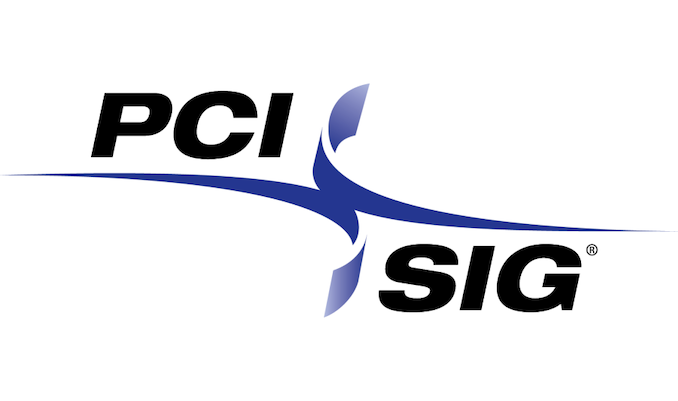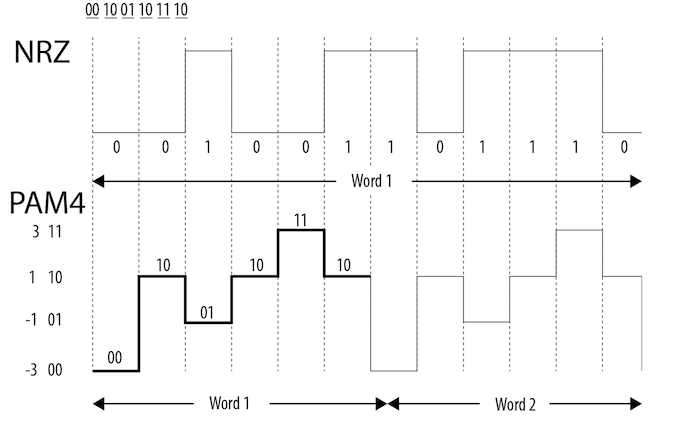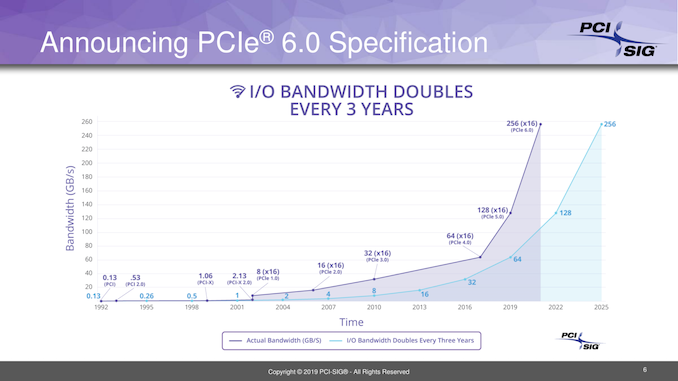PCI Express Bandwidth to Be Doubled Again: PCIe 6.0 Announced, Spec to Land in 2021
by Ryan Smith on June 18, 2019 5:00 PM EST
When the PCI Special Interest Group (PCI-SIG) first announced PCIe 4.0 a few years back, the group made it clear that they were not just going to make up for lost time after PCIe 3.0, but that they were going to accelerate their development schedule to beat their old cadence. Since then the group has launched the final versions of the 4.0 and 5.0 specifications, and now with 5.0 only weeks old, the group is announcing today that they are already hard at work on the next version of the PCIe specification, PCIe 6.0. True to PCIe development iteration, the forthcoming standard will once again double the bandwidth of a PCIe slot – a x16 slot will now be able to hit a staggering 128GB/sec – with the group expecting to finalize the standard in 2021.
As with the PCIe iterations before it, the impetus for PCIe 6.0 is simple: hardware vendors are always in need of more bandwidth, and the PCI-SIG is looking to stay ahead of the curve by providing timely increases in bandwidth. Furthermore in the last few years their efforts have taken on an increased level of importance as well, as other major interconnect standards are building off of PCIe. CCIX, Intel’s CXL, and other interfaces have all extended PCIe, and will in turn benefit from PCIe improvements. So PCIe speed boosts serve as the core of building ever-faster (and more interconnected) systems.
PCIe 6.0, in turn, is easily the most important/most disruptive update to the PCIe standard since PCIe 3.0 almost a decade ago. To be sure, PCIe 6.0 remains backwards compatible with the 5 versions that have preceded it, and PCIe slots aren’t going anywhere. But with PCIe 4.0 & 5.0 already resulting in very tight signal requirements that have resulted in ever shorter trace length limits, simply doubling the transfer rate yet again isn’t necessarily the best way to go. Instead, the PCI-SIG is going to upend the signaling technology entirely, moving from the Non-Return-to-Zero (NRZ) tech used since the beginning, and to Pulse-Amplitude Modulation 4 (PAM4).
At a very high level, what PAM4 does versus NRZ is to take a page from the MLC NAND playbook, and double the number of electrical states a single cell (or in this case, transmission) will hold. Rather than traditional 0/1 high/low signaling, PAM4 uses 4 signal levels, so that a signal can encode for four possible two-bit patterns: 00/01/10/11. This allows PAM4 to carry twice as much data as NRZ without having to double the transmission bandwidth, which for PCIe 6.0 would have resulted in a frequency around 30GHz(!).

NRZ vs. PAM4 (Base Diagram Courtesy Intel)
PAM4 itself is not a new technology, but up until now it’s been the domain of ultra-high-end networking standards like 200G Ethernet, where the amount of space available for more physical channels is even more limited. As a result, the industry already has a few years of experience working with the signaling standard, and with their own bandwidth needs continuing to grow, the PCI-SIG has decided to bring it inside the chassis by basing the next generation of PCIe upon it.
The tradeoff for using PAM4 is of course cost. Even with its greater bandwidth per Hz, PAM4 currently costs more to implement at pretty much every level, from the PHY to the physical layer. Which is why it hasn’t taken the world by storm, and why NRZ continues to be used elsewhere. The sheer mass deployment scale of PCIe will of course help a lot here – economies of scale still count for a lot – but it will be interesting to see where things stand in a few years once PCIe 6.0 is in the middle of ramping up.
Meanwhile, not unlike the MLC NAND in my earlier analogy, because of the additional signal states a PAM4 signal itself is more fragile than a NRZ signal. And this means that along with PAM4, for the first time in PCIe’s history the standard is also getting Forward Error Correction (FEC). Living up to its name, Forward Error Correction is a means of correcting signal errors in a link by supplying a constant stream of error correction data, and it’s already commonly used in situations where data integrity is critical and there’s no time for a retransmission (such as DisplayPort 1.4 w/DSC). While FEC hasn’t been necessary for PCIe until now, PAM4’s fragility is going to change that. The inclusion of FEC shouldn’t make a noticeable difference to end-users, but for the PCI-SIG it’s another design requirement to contend with. In particular, the group needs to make sure that their FEC implementation is low-latency while still being appropriately robust, as PCIe users won’t want a significant increase in PCIe’s latency.
The upshot of the switch to PAM4 then is that by increasing the amount of data transmitted without increasing the frequency, the signal loss requirements won’t go up. PCIe 6.0 will have the same 36dB loss as PCIe 5.0, meaning that while trace lengths aren’t officially defined by the standard, a PCIe 6.0 link should be able to reach just as far as a PCIe 5.0 link. Which, coming from PCIe 5.0, is no doubt a relief to vendors and engineers alike.
Even with these changes, however, as previously mentioned PCIe 6.0 is fully backwards compatible with earlier standards, and this will go for both hosts and peripherals. This means that to a certain extent, hardware designers are essentially going to be implementing PCIe twice: once for NRZ, and again for PAM4. This will be handled at the PHY level, and while it’s not a true doubling of logic (what is NRZ but PAM4 with half as many signal levels?), it does mean that backwards compatibility is a bit more work this time around. Though discussing the matter in today’s press conference, it doesn’t sound like the PCI-SIG is terribly concerned about the challenges there, as PHY designers have proven quite capable (e.g. Ethernet).
| PCI Express Bandwidth (Full Duplex) |
||||||||
| Slot Width | PCIe 1.0 (2003) |
PCIe 2.0 (2007) |
PCIe 3.0 (2010) |
PCIe 4.0 (2017) |
PCIe 5.0 (2019) |
PCIe 6.0 (2021) |
||
| x1 | 0.25GB/sec | 0.5GB/sec | ~1GB/sec | ~2GB/sec | ~4GB/sec | ~8GB/sec | ||
| x2 | 0.5GB/sec | 1GB/sec | ~2GB/sec | ~4GB/sec | ~8GB/sec | ~16GB/sec | ||
| x4 | 1GB/sec | 2GB/sec | ~4GB/sec | ~8GB/sec | ~16GB/sec | ~32GB/sec | ||
| x8 | 2GB/sec | 4GB/sec | ~8GB/sec | ~16GB/sec | ~32GB/sec | ~64GB/sec | ||
| x16 | 4GB/sec | 8GB/sec | ~16GB/sec | ~32GB/sec | ~64GB/sec | ~128GB/sec | ||
Putting all of this in practical terms then, PCIe 6.0 will be able to reach anywhere between ~8GB/sec for a x1 slot up to ~128GB/sec for a x16 slot (e.g. accelerator/video card). For comparison’s sake, 8GB/sec is as much bandwidth as a PCIe 2.0 x16 slot, so over the last decade and a half, the number of lanes required to deliver that kind of bandwidth has been cut to 1/16th the original amount.
Overall, the PCI-SIG has set a rather aggressive schedule for this standard: the group has already been working on it, and would like to finalize the standard in 2021, two years from now. This would mean that the PCI-SIG will have improved PCIe’s bandwidth by eight-fold in a five-year period, going from PCIe 3.0 and its 8 GT/sec rate in 2016 to 4.0 and 16 GT/sec in 2017, 5.0 and 32 GT/sec in 2019, and finally 6.0 and 64 GT/sec in 2021. Which would be roughly half the time it has taken to get a similar increase going from PCIe 1.0 to 4.0.
As for end users and general availability of PCIe 6.0 products, while the PCI-SIG officially defers to the hardware vendors here, the launch cycles of PCIe 4.0 and 5.0 have been very similar, so PCIe 6.0 will likely follow in those same footsteps. 4.0, which was finalized in 2017, is just now showing up in mass market hardware in 2019, and meanwhile Intel has already committed to PCIe 5.0-capable CPUs in 2021. So we may see PCIe 6.0 hardware as soon as 2023, assuming development stays on track and hardware vendors move just as quickly to implement it as they have on earlier standards. Though for client/consumer use, it bears pointing out that with the rapid development pace for PCIe – and the higher costs that PAM4 will incur – just because the PCI-SIG develops 6.0 it doesn't mean it will show up in client decides any time soon; economics and bandwidth needs will drive that decision.
Speaking of which, as part of today’s press conference the group also gave a quick update on PCIe compliance testing and hardware rollouts. PCIe 4.0 compliance testing will finally kick off in August of this year, which should further accelerate 4.0 adoption and hardware support. Meanwhile PCIe 5.0 compliance testing is still under development, and like 4.0, once 5.0 compliance testing becomes available it should open the flood gates to much faster adoption there as well.
Source: PCI-SIG


















119 Comments
View All Comments
Valantar - Wednesday, June 19, 2019 - link
That's not what I was asking about either - but rather if adopting PAM4 as an add-on (as SaturnusDK said above, as a retroactive ".05") to previous standards might be a better route to cost-efficient >PCIe 3.0 speeds as you'd avoid some of the signalling/trace length issues of 4.0 and 5.0.I appreciate the great responses though, and it seems I probably underestimated the cost/complexity of implementing PAM4 in silicon. Still, I have to wonder how this will scale as PAM4 adoption rises when PCIe 6.0 hits the market - might economics of scale bring this cost down? Complex PCBs aren't getting any cheaper any time soon, so silicon seems to be the only avenue for cost reduction to avoid the seemingly incessant price creep associated with faster I/O.
mode_13h - Wednesday, June 19, 2019 - link
I'm not an EE, but it seems to me that PAM4 still requires higher signal integrity than NRZ. It's just not as difficult as a further frequency doubling. The addition of FEC would seem to be an implicit acknowledgement of this. However, I could also imagine potential implications on practical trace length or PCB structure.mattkiss - Wednesday, June 19, 2019 - link
What's the difference between "Actual Bandwidth" and "I/O Bandwidth" on the chart?repoman27 - Wednesday, June 19, 2019 - link
"Actual Bandwidth" is the approximate aggregate bandwidth provided by the links described in the various PCI specification releases, aligned with their release date. "I/O Bandwidth" is a plot of a theoretical doubling of link bandwidth every 3 years starting with the 0.13 GB/s of the original PCI spec back in 1992. I guess this shows how well they're doing based on an arbitrary comparison that they selected in order to demonstrate how well they're doing.mode_13h - Wednesday, June 19, 2019 - link
Yeah, that was my read.It's as if they're saying "hey, we're staying ahead of the curve", except they're the ones who picked "the curve" by which to judge their progress.
IMO, it would've been more informative to fit an exponential curve to their actual schedule, so we can see roughly what rate of improvement they're delivering.
ksec - Wednesday, June 19, 2019 - link
So are there any NAND maker that has a roadmap for 16GB/s SSD in 2023? Using eight Channel that is 2GB/s, doesn't seems too far stretched?Valantar - Wednesday, June 19, 2019 - link
Are there any NAND or SSD makers with public (or even leaked) roadmaps? Not many people care much about which storage devices they'll be able to buy in 4-5 years.ksec - Thursday, June 20, 2019 - link
Yes there are roadmap for NAND. The problem is they focus on cost and capacity, and don't often mention transfer speed. My guess is that they are not sure if Transfer speed will continue to sell in the future.Kevin G - Wednesday, June 19, 2019 - link
I'm curious if PCIe 6.0 will permit PAM4 data transmission but at the reduced clocks of PCIe 4.0/3.0 etc. in a low power mode. This would still be additional bandwidth vs. the previous standards and likely saves some complexity without have to toggle between PAM4 and NRZ as often. Otherwise I'm curious what the turn around time for a PAM4-to-NRZ transition would be on the bus and how much energy could be spent thrashing across that transition.SaturnusDK - Wednesday, June 19, 2019 - link
The PCI specification dictates a maximum 36dB signal loss on both PCIe 4.0, 5.0 and 6.0. That alone should tell you that a multi-bit signal, ie. a signal with several discrete voltage states, uses more power than increasing the frequency since the signal loss has to be to the lowest discrete voltage state meaning that the transmitter will need to run at higher voltage which incurs a higher power loss. The reason for even using a multi-bit signal is due to the fact that with PCIe 5.0 we're already at 16GHz with a corresponding maximum PCB trace length of about 80mm between repeaters or signal conditioners. Doubling speed again, and thereby halving the trace length again isn't a feasible option. That is the only reason to go multi-bit. The disadvantages are too great to implement it at lower speeds.